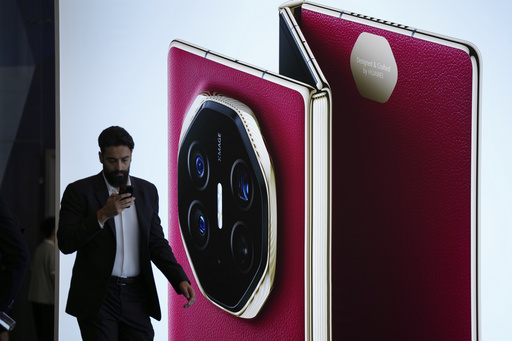
KUALA LUMPUR, Malaysia — On Tuesday, Huawei introduced the world’s first tri-fold smartphone during a global launch event in Kuala Lumpur, a development that analysts consider a notable achievement for the company amidst ongoing U.S. technology restrictions. However, various issues related to pricing, durability, supply chain, and app availability could hinder its broader success in the market.
The Huawei Mate XT, which premiered in China five months ago, is priced at 3,499 euros (approximately $3,662). While it is called a trifold phone, it features three mini-panels and only folds twice. The device boasts a remarkable thickness of 3.6 millimeters (0.14 inches) and a 10.2-inch screen, comparable in size to an Apple iPad.
Bryan Ma, vice president of device research at International Data Corporation, mentioned that “currently, Huawei stands out as a significant innovator” with its unique trifold design. He further noted that the company has achieved this position despite facing substantial obstacles such as restricted access to chips and Google services, which have acted as major hindrances for Huawei. Ma remarked that the “comeback we’ve witnessed from them over the past year has been a considerable achievement.”
As China’s first major global tech brand, Huawei finds itself at the core of a technology and trade tension between the U.S. and China. In 2019, the U.S. government cut off Huawei’s access to American technology and components, including vital services provided by Google, diminishing the appeal of its smartphones. Moreover, the U.S. has prohibited worldwide suppliers from utilizing American technology to manufacture parts for Huawei.
U.S. officials label Huawei a security threat, a claim that the company refutes. The Chinese government has accused the U.S. of misusing security concerns as a strategy to curb the progress of a competitor to American technology firms.
The Mate XT was launched in China on September 20, coinciding with the global release of Apple’s iPhone 16 series. However, given its high price, analysts like Ma express doubt about its potential to become a popular choice among consumers. “It’s not a mainstream product that consumers are likely to gravitate towards,” he stated.
During the event in Kuala Lumpur, Huawei also showcased its MatePad Pro tablet and Free Arc, its inaugural open-ear earbuds featuring ear hooks, along with other wearables. While these advanced devices highlight Huawei’s technical capabilities, their long-term viability is uncertain due to persistent challenges surrounding the global supply chain, chip availability, and software limitations, according to Ruby Lu, an analyst from TrendForce.
According to Lu, “System limitations, especially the absence of Google Mobile Services, mean that its international market opportunities remain limited.” In 2023, IDC reported that Huawei commanded a 49% market share of the foldable phone segment in China, while it secured 23% globally, trailing Samsung’s 33% share.
Looking forward, IDC predicts that the total shipments of foldable phones worldwide could increase to 45.7 million units by 2028, up from just over 20 million in the previous year. Although many leading brands have ventured into the foldable phone market, Lu emphasizes that Apple has not yet launched a competing product. “The entry of Apple into this market is anticipated to significantly impact and further stimulate growth in the foldable phone industry,” Lu concluded.

